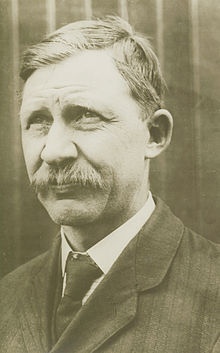Charlie Taylor (mechanic)
| Charles Edward Taylor | |
|---|---|

"[I] always wanted to learn to fly, but I never did. The Wrights refused to teach me and tried to discourage the idea. They said they needed me in the shop and to service their machines, and if I learned to fly, I'd be gadding about the country and maybe become an exhibition pilot, and then they'd never see me again."
|
|
| Born |
May 24, 1868 Cerro Gordo, Illinois |
| Died |
January 30, 1956 (aged 87) Los Angeles, California |
| Occupation | Mechanic, machinist, inventor |
| Spouse(s) | Henrietta Webbert |
Charles Edward Taylor (May 24, 1868 – January 30, 1956) was an American inventor, mechanic and machinist. He built the first aircraft engine used by the Wright brothers and was a vital contributor of mechanical skills in the building and maintaining of early Wright engines and airplanes.
Born in a log cabin on May 24, 1868, in Cerro Gordo, Illinois to William Stephen Taylor and Mary Jane Germain. Taylor worked as a binder at the Nebraska State Journal at age 12. He became a tool maker. At 24, he met and married Henrietta Webbert, who was from Dayton, Ohio. They had a child and moved to Dayton, where prospects were better. Stoddard Manufacturing Co. hired him to make farm machinery and bicycles. But when the Wright Brothers began renting from his wife's uncle a building for their bicycle shop, he went to work for them. Initially, Taylor was hired to fix bicycles, but increasingly took over running of the bicycle business as the Wright brothers spent more time on their aeronautical pursuits. By 1902, they trusted him enough to run the shop in their absence while they went to Kitty Hawk, North Carolina, to fly gliders.
When it became clear that an off-the-shelf engine with the required power-to-weight ratio was not available in the U.S. for their first engine-driven Flyer, the Wrights turned to Taylor for the job. He designed and built the aluminum-copper water-cooled engine in only six weeks, based partly on rough sketches provided by the Wrights. The cast aluminum block and crankcase weighed 152 pounds (69 kg) and were produced at either Miami Brass Foundry or the Buckeye Iron and Brass Works, near Dayton, Ohio. The Wrights needed an engine with at least 8 horsepower (6.0 kW). The engine that Taylor built produced 12.
In 1908 Taylor helped Orville build and prepare the "military Flyer" for demonstration to the U.S. Army at Fort Myer, Virginia. On September 17, the airplane crashed due to a shattered propeller, seriously injuring Orville and killing his passenger, Army lieutenant Thomas Selfridge. Taylor was among the first to reach the crash. He helped lift Selfridge out of the wreckage, then undid Orville's necktie and opened his shirt as doctors in the crowd pushed their way to the scene. Orville and Selfridge were taken away on stretchers. After that,
"...Charlie leaned against an upended wing of the wrecked Flyer, buried his face in his arms, and sobbed. A newspaperman tried to comfort him, but he was past comforting until Dr. Watters assured him that the chances for Orville's recovery were good. Then he pulled himself together and took charge of carting the wrecked Flyer back to its shed."
...
Wikipedia
